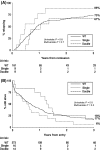The value of molecular stratification for CEBPA(DM) and NPM1(MUT) FLT3(WT) genotypes in older patients with acute myeloid leukaemia
- PMID: 26847745
- PMCID: PMC4855634
- DOI: 10.1111/bjh.13873
The value of molecular stratification for CEBPA(DM) and NPM1(MUT) FLT3(WT) genotypes in older patients with acute myeloid leukaemia
Abstract
Older adult patients (≥60 years) with acute myeloid leukaemia (AML) are generally considered to be poor-risk and there is limited information available regarding risk stratification based on molecular characterization in this age group, particularly for the double-mutant CEBPA (CEBPA(DM) ) genotype. To investigate whether a molecular favourable-risk genotype can be identified, we investigated CEBPA, NPM1 and FLT3 status and prognostic impact in a cohort of 301 patients aged 60 years or more with intermediate-risk cytogenetics, all treated intensively. Overall survival (OS) at 1 year was highest in the 12 patients (4%) that were CEBPA(DM) compared to the 76 (28%) with a mutant NPM1 and wild-type FLT3 (NPM1(MUT) FLT3(WT) ) genotype or all other patients (75%, 54%, 33% respectively), with median survival 15·2, 13·6 and 6·6 months, although the benefit was short-term (OS at 3 years 17%, 29%, 12% respectively). Combination of the CEBPA(DM) and NPM1(MUT) FLT3(WT) genotype patients defined a molecular group with favourable prognosis (P < 0·0001 in multivariate analysis), with 57% of patients alive at 1 year compared to 33% for all other patients. Knowledge of genotype in older cytogenetically intermediate-risk patients might influence therapy decisions.
Keywords: CEBPA genotype; NPM1 and FLT3 genotype; acute myeloid leukaemia; molecular prognostication.
© 2015 The Authors. British Journal of Haematology published by John Wiley & Sons Ltd.
Figures



Similar articles
-
Transplant outcomes of the triple-negative NPM1/FLT3-ITD/CEBPA mutation subgroup are equivalent to those of the favourable ELN risk group, but significantly better than the intermediate-I risk group after allogeneic transplant in normal-karyotype AML.Ann Hematol. 2016 Mar;95(4):625-35. doi: 10.1007/s00277-015-2580-z. Epub 2015 Dec 22. Ann Hematol. 2016. PMID: 26692090
-
The effect of the detection of minimal residual disease for the prognosis and the choice of post-remission therapy of intermediate-risk acute myeloid leukemia without FLT3-ITD, NPM1 and biallelic CEBPA mutations.Hematology. 2021 Dec;26(1):179-185. doi: 10.1080/16078454.2021.1880753. Hematology. 2021. PMID: 33594943
-
Prognostic significance of CEBPA mutations in a large cohort of younger adult patients with acute myeloid leukemia: impact of double CEBPA mutations and the interaction with FLT3 and NPM1 mutations.J Clin Oncol. 2010 Jun 1;28(16):2739-47. doi: 10.1200/JCO.2009.26.2501. Epub 2010 May 3. J Clin Oncol. 2010. PMID: 20439648
-
Prognostic significance of FLT3 internal tandem duplication, nucleophosmin 1, and CEBPA gene mutations for acute myeloid leukemia patients with normal karyotype and younger than 60 years: a systematic review and meta-analysis.Ann Hematol. 2014 Aug;93(8):1279-86. doi: 10.1007/s00277-014-2072-6. Epub 2014 May 7. Ann Hematol. 2014. PMID: 24801015
-
Translational implications of somatic genomics in acute myeloid leukaemia.Lancet Oncol. 2014 Aug;15(9):e382-94. doi: 10.1016/S1470-2045(14)70008-7. Lancet Oncol. 2014. PMID: 25079101 Review.
Cited by
-
Phase 3 trial of gilteritinib plus azacitidine vs azacitidine for newly diagnosed FLT3mut+ AML ineligible for intensive chemotherapy.Blood. 2022 Oct 27;140(17):1845-1857. doi: 10.1182/blood.2021014586. Blood. 2022. PMID: 35917453 Free PMC article. Clinical Trial.
-
Management of Cancer in the Older Age Person: An Approach to Complex Medical Decisions.Oncologist. 2017 Mar;22(3):335-342. doi: 10.1634/theoncologist.2016-0276. Epub 2017 Feb 20. Oncologist. 2017. PMID: 28220025 Free PMC article. Review.
-
A targeted next-generation sequencing in the molecular risk stratification of adult acute myeloid leukemia: implications for clinical practice.Cancer Med. 2017 Feb;6(2):349-360. doi: 10.1002/cam4.969. Epub 2017 Jan 10. Cancer Med. 2017. PMID: 28070990 Free PMC article.
-
Genotypic and clinical heterogeneity within NCCN favorable-risk acute myeloid leukemia.Leuk Res. 2018 Feb;65:67-73. doi: 10.1016/j.leukres.2017.12.012. Epub 2018 Jan 2. Leuk Res. 2018. PMID: 29310020 Free PMC article.
-
Mechanisms Underlying Resistance to FLT3 Inhibitors in Acute Myeloid Leukemia.Biomedicines. 2020 Jul 24;8(8):245. doi: 10.3390/biomedicines8080245. Biomedicines. 2020. PMID: 32722298 Free PMC article. Review.
References
-
- Alibhai, S.M. , Breunis, H. , Timilshina, N. , Brignardello‐Petersen, R. , Tomlinson, G. , Mohamedali, H. , Gupta, V. , Minden, M.D. , Li, M. , Buckstein, R. & Brandwein, J.M. (2015) Quality of life and physical function in adults treated with intensive chemotherapy for acute myeloid leukemia improve over time independent of age. Journal of Geriatric Oncology, 6, 262–271. - PubMed
-
- Becker, H. , Marcucci, G. , Maharry, K. , Radmacher, M.D. , Mrozek, K. , Margeson, D. , Whitman, S.P. , Wu, Y.Z. , Schwind, S. , Paschka, P. , Powell, B.L. , Carter, T.H. , Kolitz, J.E. , Wetzler, M. , Carroll, A.J. , Baer, M.R. , Caligiuri, M.A. , Larson, R.A. & Bloomfield, C.D. (2010) Favorable prognostic impact of NPM1 mutations in older patients with cytogenetically normal de novo acute myeloid leukemia and associated gene‐ and microRNA‐expression signatures: a Cancer and Leukemia Group B study. Journal of Clinical Oncology, 28, 596–604. - PMC - PubMed
-
- Buchner, T. , Berdel, W.E. , Haferlach, C. , Haferlach, T. , Schnittger, S. , Muller‐Tidow, C. , Braess, J. , Spiekermann, K. , Kienast, J. , Staib, P. , Gruneisen, A. , Kern, W. , Reichle, A. , Maschmeyer, G. , Aul, C. , Lengfelder, E. , Sauerland, M.C. , Heinecke, A. , Wormann, B. & Hiddemann, W. (2009) Age‐related risk profile and chemotherapy dose response in acute myeloid leukemia: a study by the German Acute Myeloid Leukemia Cooperative Group. Journal of Clinical Oncology, 27, 61–69. - PubMed
-
- Burnett, A. , Wetzler, M. & Lowenberg, B. (2011) Therapeutic advances in acute myeloid leukemia. Journal of Clinical Oncology, 29, 487–494. - PubMed
-
- Cornelissen, J.J. , Gratwohl, A. , Schlenk, R.F. , Sierra, J. , Bornhauser, M. , Juliusson, G. , Racil, Z. , Rowe, J.M. , Russell, N. , Mohty, M. , Lowenberg, B. , Socie, G. , Niederwieser, D. & Ossenkoppele, G.J. (2012) The European LeukemiaNet AML Working Party consensus statement on allogeneic HSCT for patients with AML in remission: an integrated‐risk adapted approach. Nature Reviews, 9, 579–590. - PubMed
Publication types
MeSH terms
Substances
Grants and funding
LinkOut - more resources
Full Text Sources
Other Literature Sources
Medical
Miscellaneous

